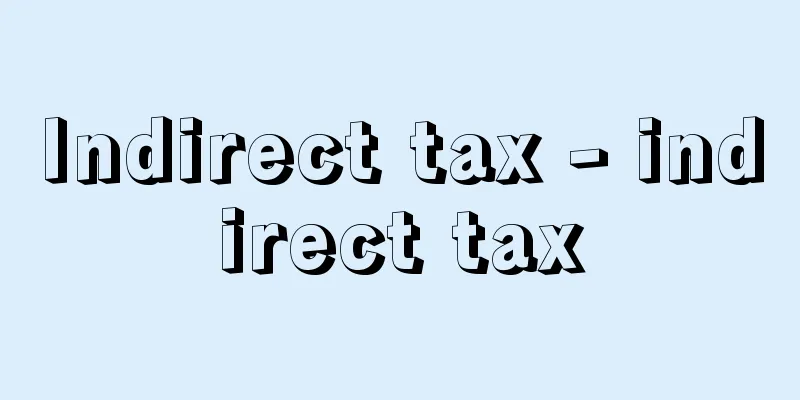Indirect tax - indirect tax

|
A tax is a type of income tax that is paid on a monthly basis by a person who is not a resident of that state. The oldest and most commonly used classification is that direct taxes are those directly levied on those who actually bear the tax, and indirect taxes are those that are shifted to those other than the taxpayer. This classification was developed by the Physiocrats and is widely accepted, but it has the disadvantage that the presence or absence of shifting of taxes, which is the basis for classification, is not clear for each tax item, but is determined by the power relations of the parties involved at different times and places. As a revision of this classification method, J.S. Mill and others have proposed a classification method based on the assumptions of the legislator's intention of pass-on, rather than on the presence or absence of pass-on as an objective fact. The legislator's intention will be affected by the objective facts of pass-on, but even when the objective facts are not necessarily clear, the criterion of the legislator's intention can be clearly defined. However, this classification method also has the disadvantage that the legislator's intention is not necessarily the same for the same tax item at different times and places. In addition, there is a technical classification system for tax administration that states that taxes levied according to tax registers or taxpayer lists are direct taxes, and taxes levied according to tax rate tables are indirect taxes, which is widely accepted in France. The classification of direct and indirect taxes is also made from the perspective of how to grasp the ability to pay. According to this classification, direct taxes are taxes levied on income or assets, which directly express the ability to pay, while indirect taxes are taxes levied on expenditures or consumption, which indirectly allow the ability to pay to be inferred. One rough indicator of tax structure is the direct-indirect tax ratio, which indicates the proportion of direct and indirect taxes in total tax revenue. Indirect taxes are said to be more efficient than direct taxes in the following respects. First, indirect taxes are primarily taxes on consumption, so they have less of a distorting effect on savings than income taxes, and therefore promote economic growth. In addition, while direct taxes often have a progressive tax rate structure and are levied at a high marginal tax rate, indirect taxes are levied proportionally to consumption, so the marginal tax rate is equal to the average tax rate and there is no distorting effect on labor supply that a high marginal tax rate of a progressive tax has. Indirect taxes on specific goods and services can also be used as a means to correct external effects, like environmental taxes. Due to the effect of indirect taxes in mitigating the distorting effects of direct taxes, an excessively high direct-indirect tax ratio is undesirable, and there have been calls for a review of the direct-indirect tax ratio. The Organization for Economic Cooperation and Development (OECD) avoids defining direct and indirect taxes, but clearly classifies personal and corporate income taxes (classification item 1000), social insurance contributions (classification item 2000), and payroll taxes (classification item 3000) as direct taxes. On the other hand, taxes on goods and services (classification item 5000) are clearly classified as indirect taxes. There is room for disagreement about the classification of property taxes (classification item 4000) as direct or indirect taxes. For example, taxes on housing can be said to be taxes on the consumption of housing services, but the OECD classifies them as direct taxes. The Japanese Ministry of Finance basically uses the OECD classification, but classifies property taxes on distribution as indirect taxes rather than direct taxes to calculate the direct/indirect tax ratio. According to the Ministry of Finance's calculations, the ratio of direct and indirect taxes in Japan in 2009 was 60:40 for national taxes and 85:15 for local taxes, which is 71:29 for the total of national and local taxes. In the UK, which uses the same classification, the ratios are 58:42 for national taxes and 100:0 for local taxes, with the total of national and local taxes being 61:39. The UK has traditionally been a country centered on direct taxes, but the direct/indirect tax ratio has fallen considerably with the substitution of value-added tax for personal income tax and corporate income tax. Latin countries such as France have traditionally had a high ratio of indirect taxes, but in 2009 France had national taxes of 54:46, local taxes of 48:52, and a total of national and local taxes of 53:47. The US is one of the few developed countries that does not impose value-added tax, but the direct/indirect tax ratio is still quite high, with national taxes of 94:6, local taxes of 58:42, and a total of national and local taxes of 78:22. [Masatoshi Hayashi] [Reference] | | | |Source: Shogakukan Encyclopedia Nipponica About Encyclopedia Nipponica Information | Legend |
|
直接税に対する語。租税を直接税と間接税とに分類することは広く行われているが、その分類の基準は一義的に規定されているわけではなく、諸説ある。 もっとも古くからあり、普通用いられる区分としては、その租税を実質的に負担する者から直接徴収する租税を直接税とし、納税者以外の者に転嫁する租税を間接税とするものがある。この分類法はフィジオクラート(重農主義者)によって発展させられ、広く受け入れられてはいるが、分類の基準となる租税の転嫁の有無ということが税目ごとに明確であるわけではなく、異なる時と所における関係者の力関係により決定されるという欠点を有している。 この分類法を修正するものとして、客観的事実としての転嫁の有無というよりは、立法者の意図する転嫁についての前提を基準とする分類法がJ・S・ミルなどにより提唱された。立法者の意図も転嫁についての客観的事実のいかんにより影響を受けるであろうが、客観的事実についてはかならずしも明らかでない場合にも、立法者の意図という基準ならば明確な形で規定できる。しかし、この分類法も、同じ税目について、時と所が異なると立法者の意図が同一になるとは限らないという欠点がある。 また、税務行政技術上の分類法として、租税台帳または納税者名簿によって課される税が直接税、税率表によってかけられる税が間接税、というものがあり、フランスにおいて広く受け入れられている。 直接税と間接税との分類は、負担能力の把握方法という観点からもなされている。この分類法によると、直接税とは、負担能力を直接的に表現する所得ないし財産に対して課される税であり、間接税とは、負担能力を間接的に推測せしめる支出ないし消費に対して課される税である。 租税構造を表す一つの大まかな指標に、税収全体に対する直接税と間接税の割合を示す直間比率というものがある。間接税は次の点で直接税よりも効率性を高めるといわれる。まず間接税は主として消費に対する税であるから、所得税と比べて貯蓄に対する歪曲(わいきょく)効果が少なく、したがって経済成長を促進する。また直接税がしばしば累進税率構造をとり高い限界税率で課税するのに対して、間接税は消費に対して比例的に課税されるから、限界税率は平均税率と等しくなり、累進税の高い限界税率が労働供給に対して与える歪曲効果は生じない。また、特定の財・サービスに対する間接税は環境税のように外部効果を是正する手段として利用できる。このような直接税の歪曲効果を緩和する間接税の効果のゆえに、過度に高い直間比率は望ましくないという理由で、直間比率の見直しが叫ばれてきた。 経済協力開発機構(OECD)では直接税と間接税の定義は回避するが、個人所得税と法人所得税(分類項目1000)、社会保険拠出金(同2000)、給与税(同3000)は明確に直接税に分類される。他方、財・サービスに対する税(同5000)は、明確に間接税に分類される。財産税(同4000)の直接税または間接税への分類については異論の余地はあり、たとえば住宅に対する税は住宅サービスの消費に対する税ともいえるが、OECDでは直接税に分類している。日本の財務省は基本的にはOECDによる分類を用いながらも、流通に対する財産税は直接税ではなく間接税に分類して直間比率を計算している。この財務省による計算では、2009年(平成21)における日本の直接税と間接税の比率は国税が60:40、地方税が85:15であり、国税と地方税の合計に対しては71:29となる。同じ分類によるイギリスが国税58:42、地方税100:0で、国税と地方税の合計に対しては61:39である。イギリスは伝統的に直接税中心の国であったが、個人所得税や法人所得税に付加価値税が代替することにより、直間比率はかなり低下した。フランスなどのラテン系国家においては伝統的に間接税の比率が高かったが、2009年のフランスでは国税が54:46、地方税が48:52、国税と地方税の合計が53:47である。アメリカは付加価値税を課税しない先進国では数少ない国の一つであるが、国税が94:6、地方税が58:42、国税と地方税の合計が78:22と直間比率はいまだかなり高い。 [林 正寿] [参照項目] | | | |出典 小学館 日本大百科全書(ニッポニカ)日本大百科全書(ニッポニカ)について 情報 | 凡例 |
<<: Indirect steelmaking process
>>: Indirect Sulfonation - A Book to Explain
Recommend
Disarray - Chaos
The titles of Japanese music pieces, Noh music and...
Coffee house - Kissashitsu
...a lounge, a parlor, a cafe. A word of the same...
Dan/Han - Tan
A unit of area in the shakkanho system. After the ...
Inanna's Descent to the Underworld - Inanna's Descent to the Underworld
… [Venus myth of ancient West Asia] In the late N...
Gennosuke Uemura - Uemura Gennosuke
...It is said that this was done to take advantag...
Dorcopsis muelleri (English spelling) Dorcopsismuelleri
…General term for a group of wallaby-like marsupi...
MLSTP - MLSTP
…However, after the coup in Portugal in April 197...
Akaoka [town] - Akaoka
A former town in Kami County facing Tosa Bay in ea...
Rice blast fungus - Rice blast fungus
…(chemical formula) An agricultural antibiotic pr...
Memorial de Sainte-Helène (English)
…In December 1816, he was exiled by Governor Huds...
Ion flotation - Ion flotation
...This is a method in which the gas dissolved in...
Kjellmaniella gyrata (English name) Kjellmaniellagyrata
…A group of seaweeds in the brown algae family La...
Great Indian Plains
…The word Hindustan comes from the Persian word f...
Yellow squid bill - Yellow squid bill
...It grows in warm areas from Honshu to Kyushu, ...
Tadatoshi Aoyama
Year of death: Kan'ei 20 (1643) Year of birth:...









![Tarudama [Hot Spring] - Tarudama](/upload/images/67cc27a0502f6.webp)